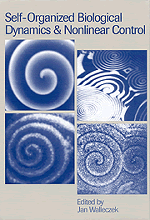 Self-Organized Biological Dynamics and Nonlinear Control
Self-Organized Biological Dynamics and Nonlinear Control Published online by Cambridge University Press: 14 August 2009
Introduction
The transport of life-sustaining materials across the cell membrane consumes large fractions of the total energy expenditures of cells. As such, membrane transport is tightly regulated and controlled. Membrane proteins are mostly responsible for the transport of molecules and ions in and out of the cell. There are many classes of membrane transporters. A simple classification lists three types: channels, carriers and pumps. Channels and carriers are passive downhill transporters, whereas pumps are active uphill transporters. However, a channel may also be able to fulfill the role of an uphill transporter by coupling a downhill transport reaction to an uphill transport reaction: the transporter, however, will still be a downhill transporter overall. Beside proteins, a small number of transporters come from heterocyclic organic compounds. These small molecules can serve as ion channels or ion carriers, but only a protein with enzymatic activity can function as a pump. All transporters are embedded in lipid bilayers and, for a pump to function, some degrees of freedom must be hindered or restricted. As I shall discuss later, this feature of a pump is crucial for capturing energy from a periodically oscillating or randomly fluctuating force field (Tsong and Astumian, 1986, 1988; Tsong, 1990, 1992).
In order for a pump to capture energy another feature is essential: it must be able to interact effectively with a driving force, e.g., an electric field or an acoustic field (Tsong and Astumian, 1986, 1988).
To save this book to your Kindle, first ensure [email protected] is added to your Approved Personal Document E-mail List under your Personal Document Settings on the Manage Your Content and Devices page of your Amazon account. Then enter the ‘name’ part of your Kindle email address below. Find out more about saving to your Kindle.
Note you can select to save to either the @free.kindle.com or @kindle.com variations. ‘@free.kindle.com’ emails are free but can only be saved to your device when it is connected to wi-fi. ‘@kindle.com’ emails can be delivered even when you are not connected to wi-fi, but note that service fees apply.
Find out more about the Kindle Personal Document Service.
To save content items to your account, please confirm that you agree to abide by our usage policies. If this is the first time you use this feature, you will be asked to authorise Cambridge Core to connect with your account. Find out more about saving content to Dropbox.
To save content items to your account, please confirm that you agree to abide by our usage policies. If this is the first time you use this feature, you will be asked to authorise Cambridge Core to connect with your account. Find out more about saving content to Google Drive.